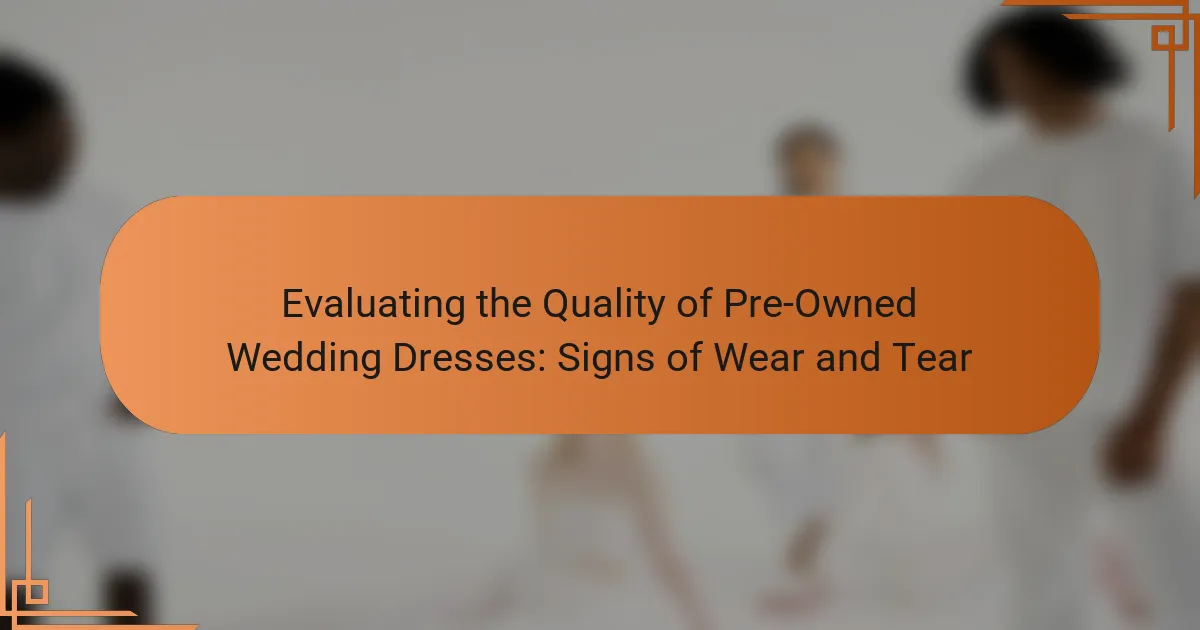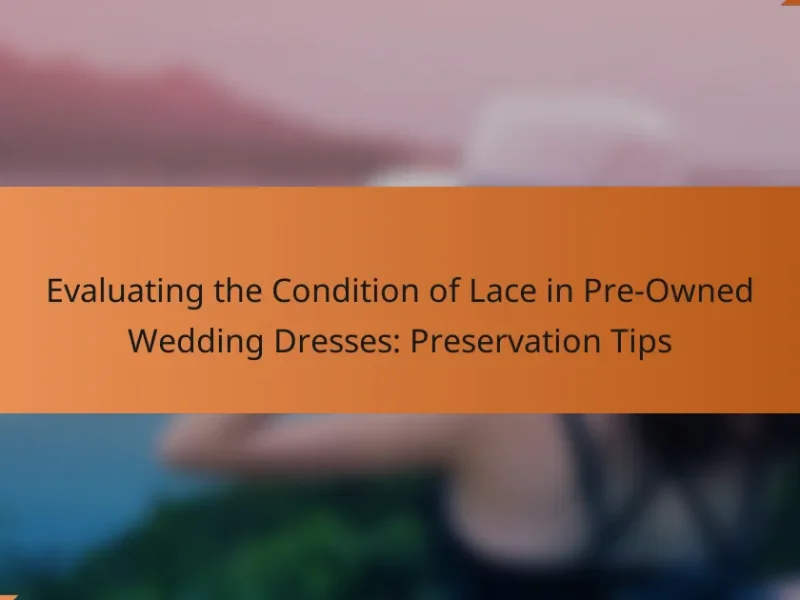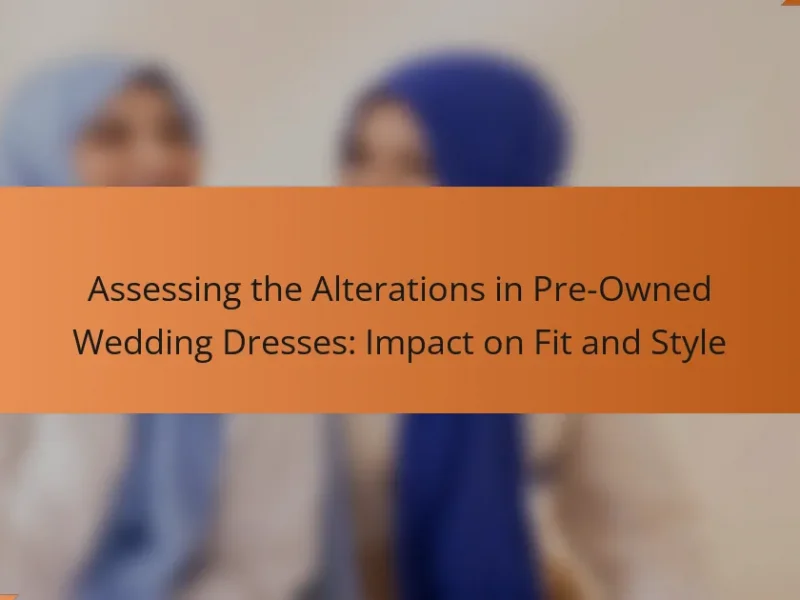Evaluating the quality of pre-owned wedding dresses involves assessing several key factors, including signs of wear, fabric condition, and alterations. Important indicators of wear include visible stains, fraying, and loose seams, while fabric should be checked for discoloration or damage. It is crucial to inspect the lining and embellishments, as well as to verify the dress’s original designer, which can impact its value and desirability. Understanding the dress’s history and previous alterations can provide additional context for its overall condition. Comprehensive evaluation, including detailed photographs and potential try-ons, is essential for making an informed purchasing decision.
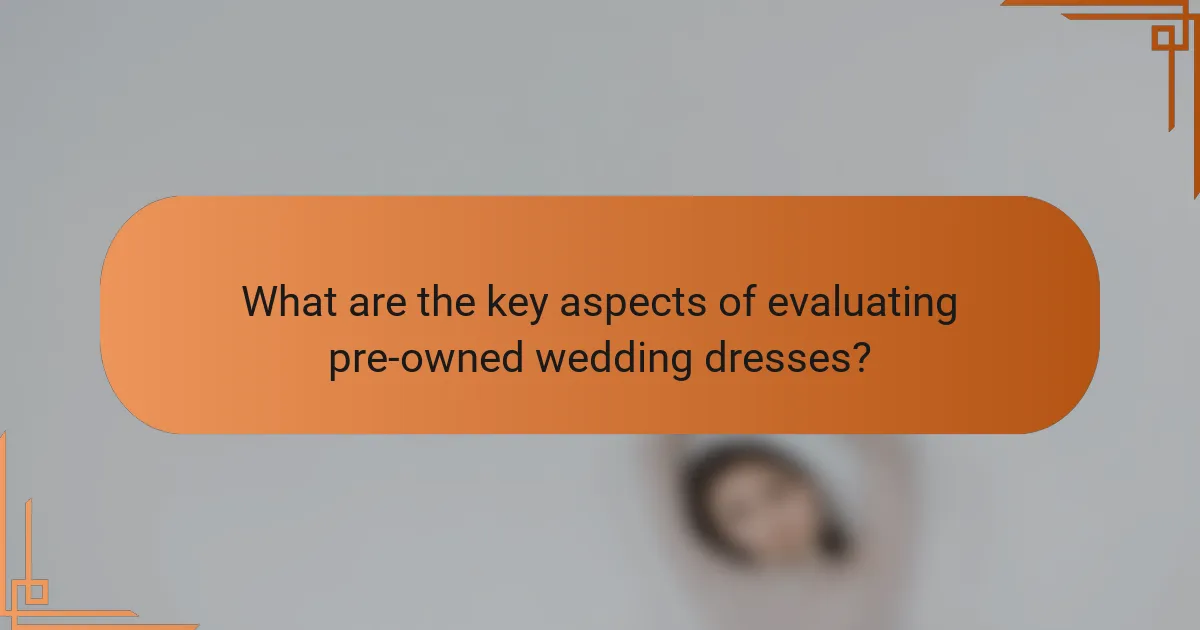
What are the key aspects of evaluating pre-owned wedding dresses?
The key aspects of evaluating pre-owned wedding dresses include checking for signs of wear, assessing fabric condition, and examining alterations. Signs of wear can include stains, fraying, or loose seams. The fabric condition should be assessed for discoloration or damage. Alterations may affect the dress’s fit and design. Additionally, inspecting the lining and any embellishments is essential. Understanding the dress’s history can provide context on its condition. Finally, verifying the original designer can influence value and desirability.
How can you assess the overall condition of a pre-owned wedding dress?
To assess the overall condition of a pre-owned wedding dress, examine it for visible signs of wear. Check for stains, discoloration, and fabric damage. Inspect seams and stitching for any fraying or loose threads. Look for missing embellishments or alterations that may affect fit. Evaluate the dress’s lining for tears or wear. Assess the condition of any beading or lace details. Finally, consider the dress’s age and storage history, as these factors can impact its condition. Each of these steps provides a comprehensive view of the dress’s overall quality.
What signs of wear and tear should you look for in fabric?
Signs of wear and tear in fabric include fraying edges, discoloration, and fading. Fraying occurs at seams and hems, indicating potential weakness. Discoloration often appears as spots or uneven patches, suggesting stains or damage. Fading can result from sun exposure or frequent washing, diminishing the fabric’s original color. Additionally, pilling or bobbling indicates wear on the surface, affecting texture. Loose threads may signal overall deterioration, while holes or tears indicate significant damage. Inspecting these signs helps assess the quality of pre-owned wedding dresses.
How do alterations impact the quality of a pre-owned wedding dress?
Alterations can significantly impact the quality of a pre-owned wedding dress. Proper alterations can enhance fit and comfort, making the dress more wearable. However, poorly executed alterations may lead to structural issues. For example, uneven hems or misaligned seams can detract from the overall appearance. Additionally, alterations may affect the original fabric integrity. If the fabric is over-stretched or improperly handled, it can weaken and fray. Reputable tailors often maintain quality standards, ensuring that alterations do not compromise the dress. Therefore, the quality of alterations directly influences the longevity and aesthetic of a pre-owned wedding dress.
What specific features indicate the quality of a pre-owned wedding dress?
The quality of a pre-owned wedding dress is indicated by several specific features. First, check the fabric for signs of wear. High-quality fabrics, such as silk or satin, should have minimal pilling or fraying. Second, examine the stitching. Tight, even stitches are a hallmark of quality craftsmanship. Third, inspect for discoloration or stains, particularly around the hem and bodice. Fourth, assess the condition of any embellishments, such as beading or lace. Intact and securely attached details suggest better quality. Fifth, consider the dress’s structure. A well-constructed dress will maintain its shape without sagging. Lastly, verify the brand reputation. Established designers typically indicate higher quality standards. These features collectively provide insight into the overall quality of a pre-owned wedding dress.
What role does the designer play in the dress’s quality?
The designer plays a crucial role in the dress’s quality. Designers influence material selection, craftsmanship, and construction techniques. High-quality fabrics and innovative designs often lead to better durability. Established designers typically adhere to strict quality control standards. This ensures consistent production and minimizes defects. Additionally, a designer’s reputation can reflect the dress’s overall quality. Dresses from renowned designers often retain value over time. Therefore, the designer’s expertise directly impacts the longevity and appearance of the dress.
How does the dress construction affect its longevity?
Dress construction significantly impacts its longevity. High-quality materials and techniques enhance durability. Reinforced seams prevent fraying and tearing over time. A well-structured bodice maintains shape and support. Fabrics such as silk or satin can wear differently than polyester. The type of lining also affects how the dress withstands wear. Dresses with proper stitching and finishing details last longer. Regular maintenance can further extend the life of a dress.
Why is it important to check for damage in pre-owned wedding dresses?
It is important to check for damage in pre-owned wedding dresses to ensure their quality and longevity. Wedding dresses can be expensive, so identifying any wear and tear protects the investment. Damage may include stains, tears, or fabric degradation. These issues can affect the dress’s appearance and structural integrity. Checking for damage allows for necessary repairs before the wedding day. It also ensures the dress fits properly and looks pristine. Additionally, some damages may not be easily visible, making thorough inspection crucial. Ultimately, this process helps maintain the dress’s beauty and value.
What types of damage are most common in pre-owned wedding dresses?
Common types of damage in pre-owned wedding dresses include stains, tears, and discoloration. Stains often result from food, drink, or makeup during the wedding. Tears can occur in seams or fabric due to wear. Discoloration may happen from prolonged exposure to light or improper storage. Additionally, beadwork may loosen or fall off over time. These issues can significantly affect the dress’s overall appearance and integrity. Regular inspection and proper care are essential for maintaining the quality of pre-owned wedding dresses.
How can you evaluate the potential for repair on damaged dresses?
To evaluate the potential for repair on damaged dresses, inspect the extent of the damage. Look for tears, stains, or missing embellishments. Assess the fabric type and its ability to withstand repairs. Identify if the damage is localized or widespread. Check for structural integrity, including seams and zippers. Consider the cost of repair versus the dress’s value. Consult a professional tailor for expert advice on complex repairs. Tailors can provide insights on feasible restoration methods.
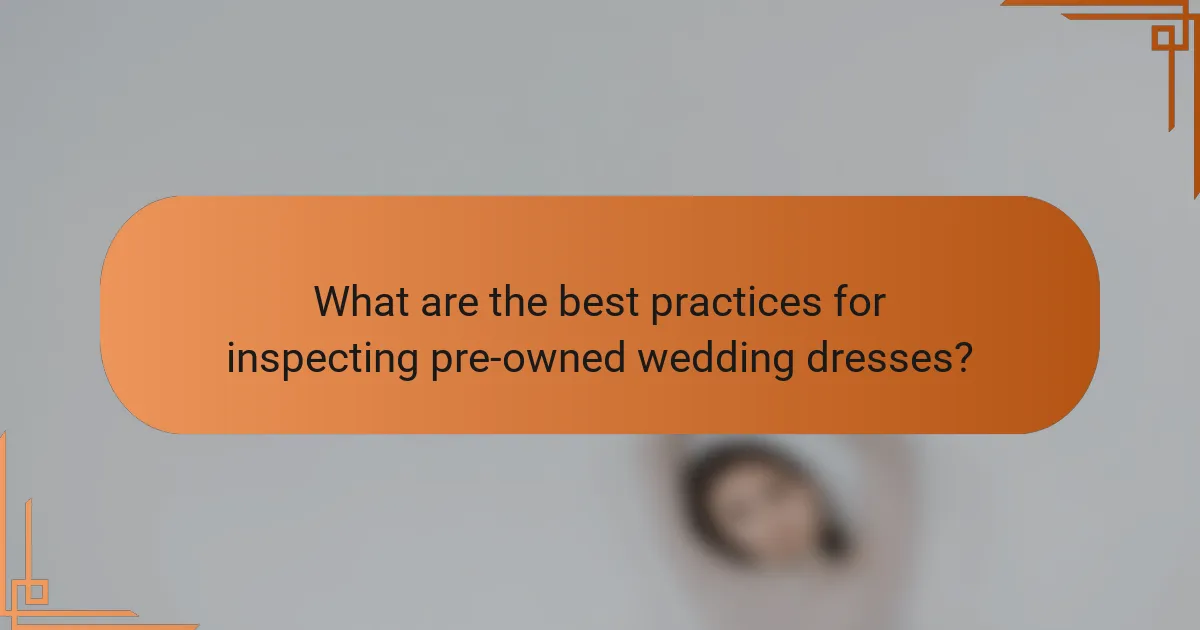
What are the best practices for inspecting pre-owned wedding dresses?
Examine the dress for visible stains or discoloration. Check the fabric for fraying or loose threads. Inspect seams for any signs of tearing or weakness. Look for missing or damaged embellishments like beads or lace. Assess the zipper functionality to ensure it operates smoothly. Verify the overall shape and structure of the dress. Consider the dress’s age and previous alterations. Take note of any strong odors that may indicate damage.
How do you conduct a thorough inspection of a pre-owned wedding dress?
To conduct a thorough inspection of a pre-owned wedding dress, start by examining the fabric for any stains or discoloration. Check for visible wear, such as fraying or thinning in the seams. Inspect the lining for tears or damage, as it can indicate overall dress condition. Look for missing beads, sequins, or embellishments that may affect the dress’s appearance. Test the zippers and buttons to ensure they function properly. Review the dress’s hem for any signs of alterations or unevenness. Consider the overall shape and structure of the dress to identify any potential issues. A detailed inspection can reveal the dress’s quality and suitability for use.
What tools or techniques can aid in the inspection process?
Visual inspection is a primary technique for assessing pre-owned wedding dresses. This method involves examining the fabric, seams, and embellishments for signs of wear and damage. A magnifying glass can enhance visibility of small defects. Lighting tools, such as handheld LED lights, help reveal stains or discoloration. Measuring tools, like fabric rulers, assist in checking dimensions against original specifications. A color chart aids in identifying color fading or mismatches. Using a checklist ensures that all critical areas are inspected thoroughly. These tools and techniques collectively enhance the accuracy of the inspection process.
How can you identify hidden flaws that may not be immediately visible?
To identify hidden flaws in pre-owned wedding dresses, conduct a thorough inspection. Examine the fabric under different lighting conditions. Look for discoloration, stains, or fading that may not be apparent. Check seams and stitching for loose threads or unraveling. Inspect linings for wear or damage. Use a magnifying glass to spot small tears or fabric pulls. Pay attention to the condition of zippers and fasteners. Lastly, consider professional cleaning to reveal flaws that may be hidden by dirt.
What should you consider when trying on a pre-owned wedding dress?
When trying on a pre-owned wedding dress, consider its overall condition. Check for visible signs of wear, such as stains, tears, or frayed seams. Inspect the fabric for any fading or discoloration. Ensure that all closures, like zippers and buttons, function properly. Assess the fit and comfort of the dress while wearing it. Take note of any alterations that may have been made previously. Verify if the dress has been cleaned or requires professional cleaning. Lastly, consider the return policy in case it does not meet your expectations.
How does fit impact your evaluation of a dress’s quality?
Fit significantly impacts the evaluation of a dress’s quality. A well-fitting dress enhances the overall appearance and comfort. It indicates proper construction and design, which are hallmarks of quality. Conversely, a poor fit can suggest issues like incorrect sizing or manufacturing defects. For example, gaping at the seams may reveal inadequate tailoring. Additionally, a dress that fits well will drape correctly, showcasing the fabric’s texture and pattern. This visual appeal is often associated with higher quality materials. In summary, fit is a key indicator of a dress’s craftsmanship and overall quality.
What adjustments might be needed, and how do they affect the dress’s value?
Adjustments may include alterations for fit, repairs for damage, or cleaning for stains. Each adjustment can impact the dress’s value. Proper fit increases desirability and can enhance resale value. Repairs restore the dress’s original condition, potentially maintaining or increasing value. However, poorly executed alterations can decrease value. Cleaning removes stains and odors, improving appearance and marketability. The extent and quality of these adjustments directly influence buyer perception and price.
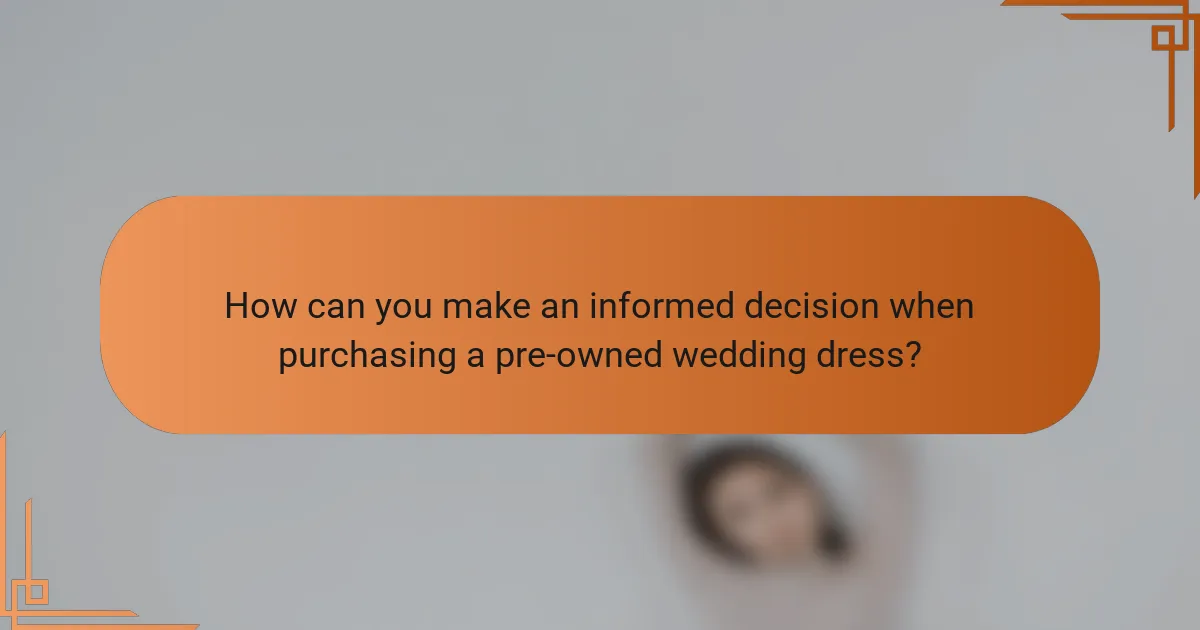
How can you make an informed decision when purchasing a pre-owned wedding dress?
To make an informed decision when purchasing a pre-owned wedding dress, thoroughly inspect the dress for signs of wear and tear. Check for any stains, tears, or loose seams. Evaluate the condition of the fabric and lining. Look for discoloration, especially in areas like the hem and underarms. Request detailed photographs from the seller, showcasing all angles and any imperfections. Verify the dress’s authenticity by checking labels and tags. If possible, try the dress on to assess fit and comfort. Research the brand and style to understand its original price and resale value. Finally, ask about the dress’s history, including previous alterations and cleaning.
What factors should influence your purchasing decision?
Key factors that should influence your purchasing decision include the condition of the dress, price, and designer brand. Assessing the condition involves checking for signs of wear and tear, such as stains, tears, or alterations. A dress in excellent condition may justify a higher price. Price comparisons with similar dresses can help determine if the cost is fair. The designer brand can also affect value; well-known brands typically retain higher resale values. Additionally, customer reviews and return policies are crucial for ensuring satisfaction. These factors collectively guide informed purchasing decisions in the pre-owned wedding dress market.
How do price and condition correlate in the context of pre-owned wedding dresses?
The price of pre-owned wedding dresses correlates directly with their condition. Generally, dresses in excellent condition command higher prices. Dresses that show signs of wear, such as stains or tears, are priced lower. The overall market trend indicates that pristine dresses can sell for 50% to 70% of their original retail price. In contrast, heavily worn dresses may sell for only 20% to 30% of the original price. Buyers often prioritize condition when making purchasing decisions. Therefore, the condition serves as a key determinant of price in the pre-owned wedding dress market.
What resources are available for verifying the authenticity of a dress?
Authentication resources for a dress include brand-specific certificates of authenticity. Many luxury brands provide these documents upon purchase. Online databases also exist for verifying designer items. Websites like The RealReal and Vestiaire Collective offer authentication services. Professional appraisers can assess the dress’s quality and authenticity. Social media groups often share tips on identifying genuine items. Fashion forums may also provide insights from experienced collectors. Utilizing these resources helps ensure a dress’s authenticity.
What are some tips for maintaining the quality of a pre-owned wedding dress?
To maintain the quality of a pre-owned wedding dress, proper care is essential. Store the dress in a cool, dry place away from direct sunlight. Use a breathable garment bag to protect it from dust and moisture. Avoid hanging the dress on a hanger for long periods to prevent stretching. Clean the dress according to the fabric type; professional dry cleaning is often recommended. Inspect the dress regularly for any signs of wear or damage. If repairs are needed, consult a professional seamstress experienced with wedding gowns. These practices help preserve the dress’s condition and longevity.
How should you store a pre-owned wedding dress to preserve its condition?
Store a pre-owned wedding dress in a cool, dry place to preserve its condition. Use a breathable garment bag made of cotton or muslin. Avoid plastic covers, as they can trap moisture and cause mildew. Ensure the dress is clean before storage to prevent stains. Fold the dress carefully and avoid hanging it to prevent stretching. Place acid-free tissue paper between layers to maintain its shape. Regularly check the dress for any signs of damage or deterioration. These methods help maintain the fabric’s integrity and appearance over time.
What cleaning methods are safe for pre-owned wedding dresses?
Safe cleaning methods for pre-owned wedding dresses include dry cleaning and gentle hand washing. Dry cleaning uses solvents that effectively remove stains without damaging delicate fabrics. It is recommended for most wedding dresses, especially those made from silk or lace. Gentle hand washing is suitable for dresses that are not heavily soiled. This method involves using cold water and a mild detergent. It helps preserve the dress’s fabric and embellishments. Spot cleaning can also be effective for small stains. Using a soft cloth and a gentle cleaner can minimize damage. Always test any cleaning method on a hidden area first. Following these methods helps maintain the dress’s quality and appearance.
The main entity of this article is pre-owned wedding dresses. The article provides a detailed examination of how to evaluate the quality of these dresses, focusing on key aspects such as signs of wear, fabric condition, alterations, and the influence of designer reputation. It outlines specific features that indicate dress quality, common types of damage, and best practices for inspection and maintenance. Additionally, it discusses factors that impact purchasing decisions, including price correlation with condition and resources for verifying authenticity.
